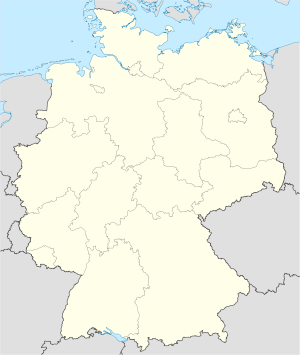- Coleman Army Airfield
-
Coleman Barracks/Coleman Army Airfield
Mannheim/Sandhofen Airfield (Y-79)Baden-Württemberg, Germany Type Military Garrison (Closed) Coordinates 49°33′47″N 008°27′46″E / 49.56306°N 8.46278°E Built 1925 In use 1937–1945 (Luftwaffe)
Apr–July 1945 (USAAF)
Jul 1945–present (United States Army)Coleman Barracks/Coleman Army Airfield (ICAO: ETOR) is a United States Army military installation located in the Sandhofen district of Mannheim, Germany. It is assigned to U.S. Army, Europe (USAREUR) and administered by the U.S. Army Installation Management Command-Europe (IMCOM-E). Coleman Barracks should not be confused with the former "Coleman Kaserne", located in Gelnhausen.
Contents
History
The first commercial airport in Mannheim was founded on 16 May 1925, as Flughafen Mannheim-Heidelberg-Ludwigshafen in the northern district of Sandhofen. With its opening Mannheim became part of an important air track, running from north to south and viceversa. In the late 1920s and early 1930s Deutsche Aero Lloyd operated cargo and passenger flights from Hamburg to Zürich stopping in Mannheim. Balair from Switzerland flew between Geneva and Amsterdam via Basel, Mannheim, Frankfurt, and Essen. Badisch-Pfälzische Luftverkehrs AG operated the black forest route to Konstanz, via Karlsruhe, Baden Baden and Villingen.
In 1926 the airfield was transferred to Mannheim-Neuostheim, now called Mannheim City Airport. The airfield in Sandhofen was closed to the public and rebuilt as the Fliegerhorst-Kaserne in 1937 as a German Air Force base. At the beginning of World War II, the II/JG 53 (2nd Group, Jagdgeschwader 53) fighter unit "Pik-As" (Ace of Spades) was based here, commanded by one of Germany's top combat pilots, Hans Moelders. This unit operated 43 new Bf109 E-1's fighter aircraft at the start of the war. Also stationed at the airbase on the first day of the war was one staffel (squadron) of JG 72 operating 16 of the older Ar68 biplane fighters then being used as a primitive night fighter. In September 1944 a concentration camp was installed on the site which was operated and guarded by the SS, holding 80 POWs from Poland, Luxembourg and Russia.
After World War II, the United States Army took over the barracks in the fall of 1945, giving it the temporary name of "Y-79". Until mid-1949 the area was used as a collecting point for unserviceable automobile material and for surplus storage. In 1951, a replacement depot was established at Coleman Barracks and served as the staging area for all troops arriving in Germany. Throughout its operation by the U.S. Army, rumors have circulated of an extensive set of tunnels beneath the airfield. There were tunnels under the base, there were a number of underground hangers out behind the Signal Corps barracks. The tunnels and other underground facilities were flooded after the war. There was an alley that ran behing the barracks and as you went down the slope there were numerous bunker entrances there, which were all locked.
Its current name commemorates Lieutenant Colonel Wilson D. Coleman.[1]
Location
The airport is located 8.5 km (5.28 mi) north of the Mannheim city center in the district of Sandhofen, 2.5 km (1.6 mi) east of the river Rhine and 3 km (1.86 mi) south of Lampertheim.
It is surrounded by the Autobahn 6 (A6) to the south and a state highway (Bundesstraße 44 (B44)) to the west; the Riedbahn train line (between Frankfurt and Mannheim) runs 1.6 km (1 mi) to the east.
Runways
The airport has one paved runway (900 m (2954 ft) x 20 m (67 ft)). The runway offers Precision Approach Path Indicator and illumination. There have been discussions about extending the runway to 1200 metres, but these plans were withdrawn due to severe protests by nearby residents. The airfield is in use from 06:30 – 23:59 daily. Radar approach has been available since June 2002.
Coleman is the only U.S. Army airfield in Germany that has its own approach control zone and provides approach control for several airports in the vicinity, both military and civilian, such as Mannheim City Airport (civilian), Speyer airfield (civilian), Worms airfield (civilian), and Heidelberg Army Airfield (military).
Buildings
A new state of the art six-story control tower was built in 2004. Besides air-conditioned offices, briefing-rooms, restrooms and an elevator, the tower accommodates the Coleman radar approach control room. The only US-Army helicopter maintenance facility in Europe is located at Coleman Barracks. [2] The only US-Army military prison in Europe, the United States Army Corrections Facility – Europe, is located at Coleman Barracks.
Air Traffic
Being the only maintenance base for Sikorsky UH-60 Black Hawk and Boeing AH-64 Apache helicopters in Europe, Coleman Airfield has more take-offs and landings than any other US Army airfield in Germany. The Coleman Aero Club (CAC) is the only military non-profit flying organization in Europe. The CAC provides flight training to member forces of NATO, the United States Armed Forces, and civilians. It operates a fleet of several US-registered Cessna aircraft.
Tenant Activities
In 2004, the American Forces Network (AFN)- Europe consolidated its headquarters and Radio/TV studios from Frankfurt and Heidelberg to Coleman Barracks. Coleman Barracks also has a small post exchange (PX) and bowling alley.
See also
Notes
 This article incorporates public domain material from websites or documents of the Air Force Historical Research Agency.
This article incorporates public domain material from websites or documents of the Air Force Historical Research Agency.- ^ Lieutenant Colonel Wilson Dudley Coleman, 1935 graduate of the United States Military Academy, was killed in action on 30 July 1944, in Saint-Denis, France, after having single-handedly halted a German tank column with Bazooka fire. LTC Coleman was posthumously awarded the Distinguished Service Cross and interred at Arlington National Cemetery on 25 January 1949. [1]
Categories:- United States Army airfields
- United States Army posts
- Mannheim
- Military facilities of the United States in Germany
- United States Army Corrections Command
Wikimedia Foundation. 2010.

